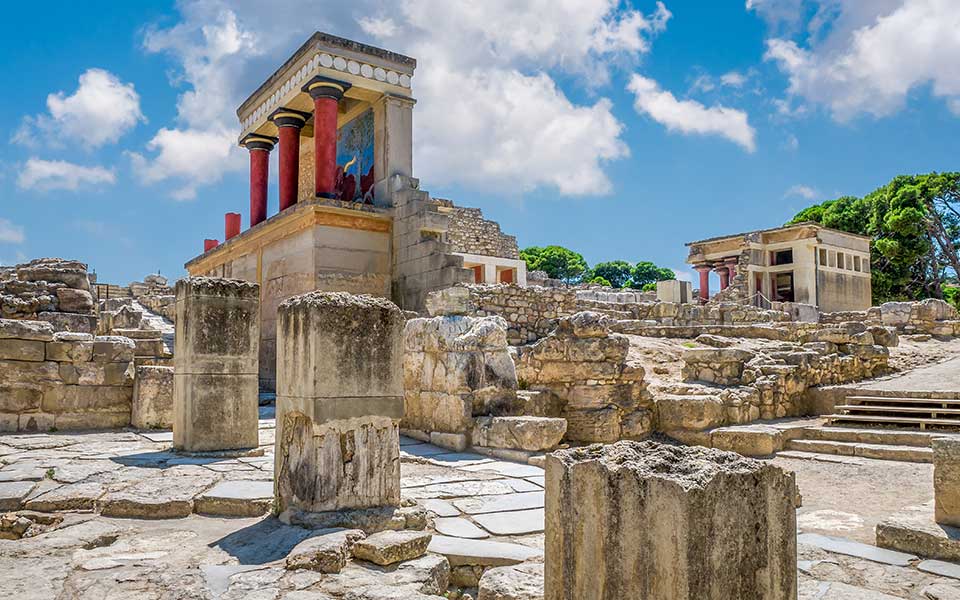Crete, the largest and most populous of the Greek islands, is a treasure trove of ancient history and archaeological wonders. Whether you’re a history buff or simply looking to add some Indiana Jones-style cultural exploration to your holiday, Crete offers a plethora of ancient sites that promise to captivate and inspire.
Here are five must-visit archaeological sites in Crete that you should include in your itinerary.
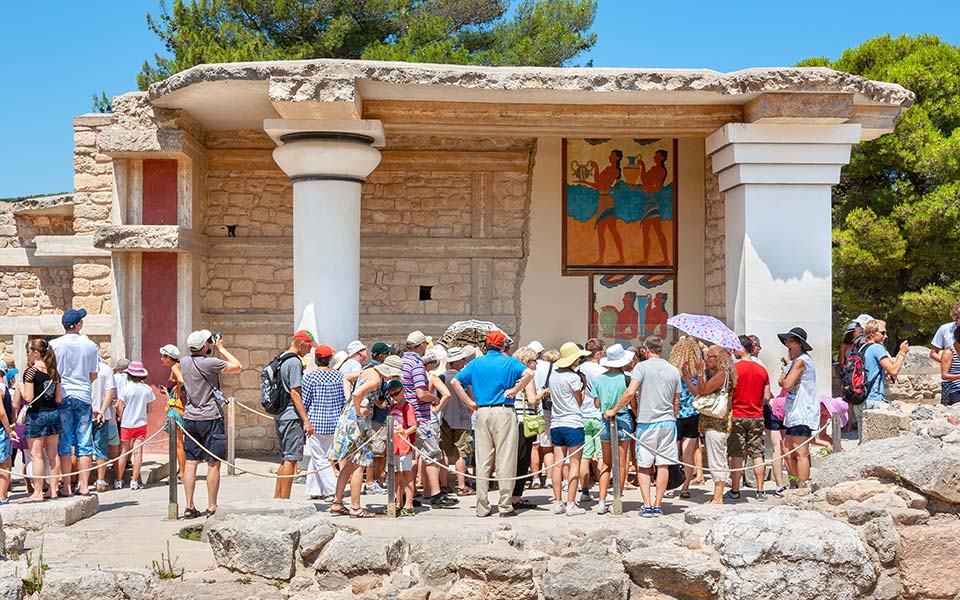
© Shutterstock
The Palace of Knossos
The Palace of Knossos, located 5km south of the modern city of Heraklion, is arguably the most famous archaeological site in Crete and the second most visited site in Greece, attracting over a million visitors each year. This sprawling urban complex, often referred to as Europe’s oldest city, was the ceremonial and political center of the mysterious Minoan civilization, which flourished from approximately 2000 to 1400 BC. Steeped in myth and history, the palace is not only an architectural marvel but also a key to understanding the early development of Europe’s first advanced civilization.
Integral to the study of the Bronze Age Minoans, Knossos is a testament to their sophisticated architectural skills. The site was systematically excavated by pioneering British archaeologist Sir Arthur Evans (1851-1941) in the early 20th century, revealing elaborate wall frescoes, advanced plumbing systems, and storerooms filled with clay tablets inscribed with Linear A and Linear B scripts, the earliest known writing systems in Europe.
The site is dominated by the monumental “Palace of Minos” – the seat of power of the mythical king Minos – and is intertwined with some of Greek mythology’s most captivating stories. According to legend, king Minos commissioned the architect Daedalus to build a labyrinth to house his son, the Minotaur, a creature that was half-man, half-bull. This mythological maze is believed to be inspired by the palace’s intricate layout. Additionally, the myth of Theseus and the Minotaur, in which the hero Theseus slays the beast with the help of Minos’ daughter, Ariadne, further adds to the site’s allure and mystical significance.
Information
Location: 5km south of Heraklion.
Opening Hours: Typically open daily from 8:00am to 8:00pm during the summer months.
Ticket Price: Around €15 for adults, with discounts for children and seniors.
Accessibility: The site is partially accessible to those with mobility issues, but some areas may be challenging due to uneven terrain.
For more information, visit the website.
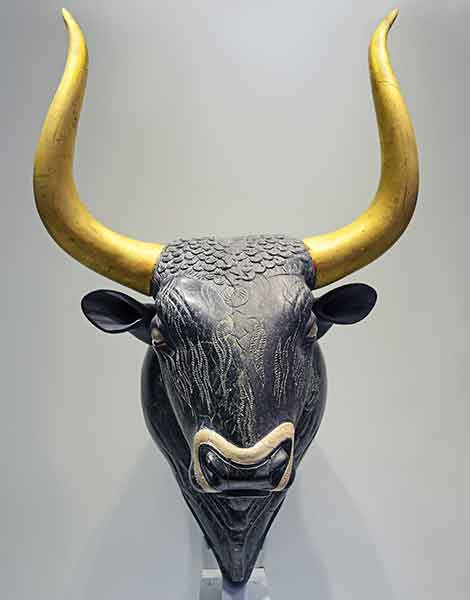
© Shutterstock
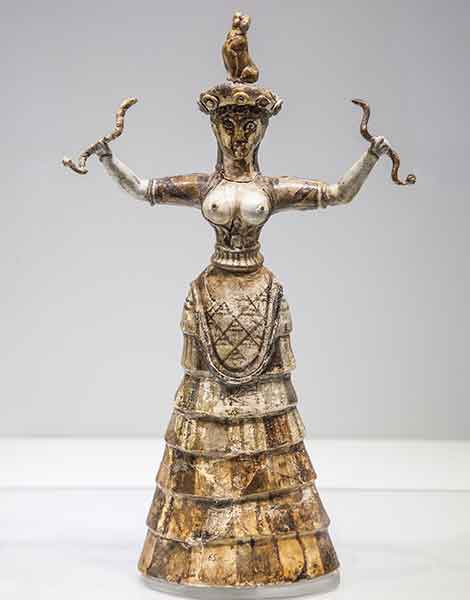
© Shutterstock
Highlights
Central Court: The heart of the palace, where ceremonies and gatherings took place.
Grand Staircases: Leading to multiple levels, indicative of the palace’s complex structure.
Residential Quarters: Private apartments for the royal family and palace elites, featuring advanced plumbing systems.
Workshops and Storerooms: Areas where artisans crafted goods and surplus food was stored, including large quantities of grain, oil, and wine. Look out for the remains of the enormous storage magazines, filled with giant pithoi (ceramic storage jars).
Throne Room: A ceremonial room with a gypsum throne, believed to be the oldest throne in Europe.
Art and Frescoes: The walls of Knossos are adorned with vibrant frescoes that provide a glimpse into Minoan life and religious practices. Scenes of nature, sporting activities such as bull-leaping, and processions highlight the artistic achievements and cultural values of the island’s Bronze Age inhabitants. Many of the original frescoes from the site, as well as numerous portable artifacts, are on display at the Heraklion Archaeological Museum.
Phaistos Palace
Situated on the eastern point of a ridge overlooking the fertile Messara Plain of south central Crete and with spectacular views of the surrounding mountains, Phaistos Palace is one of the island’s most significant archaeological sites. As the second-largest Minoan palace, it rivals Knossos in historical importance but is less well known to the majority of visitors. The palace’s serene location and the discovery of the enigmatic Phaistos Disc, currently on display at the Heraklion Archaeological Museum, make it a captivating destination for history enthusiasts and casual visitors alike.
Phaistos served as a major administrative and religious center during the Minoan Bronze Age, flourishing from approximately 1900 to 1450 BC, although it was first inhabited as early as the mid-4th millennium BC. The site was first excavated in the first years of the 20th century by a team of Italian archaeologists led by Federico Halbherr (1857-1930) and Luigi Pernier (1874-1937). Their discoveries revealed a highly complex and well-organized society, highlighting the advanced nature of Minoan culture.
The palace is renowned for its strategic location, boasting breathtaking views of the Messara Plain and the surrounding mountains. This picturesque setting enhances the visitor experience, allowing for moments of reflection amidst the ruins.
Information
Location: 62km south of Heraklion.
Opening Hours: Generally open from 8:00am to 8:00pm in the summer months.
Ticket Price: Approximately €8 for adults, with reduced prices for children and seniors.
Accessibility: The site has uneven terrain, so comfortable footwear is recommended. Some areas may be challenging for those with mobility issues.

© C messier, edit by Bammesk / Public domain

© C messier, edit by Bammesk / Public domain
Phaistos Disc
One of the most intriguing artifacts discovered at Phaistos is the famous Phaistos Disc, on display at the Heraklion Archaeological Museum. This clay tablet, 15 cm in diameter and dating to sometime in the mid-2nd millennium BC (c. 1700), is inscribed with a spiral of 45 mysterious symbols (glyphs). Despite extensive study, the disc’s script remains undeciphered, adding an element of mystery to the site.
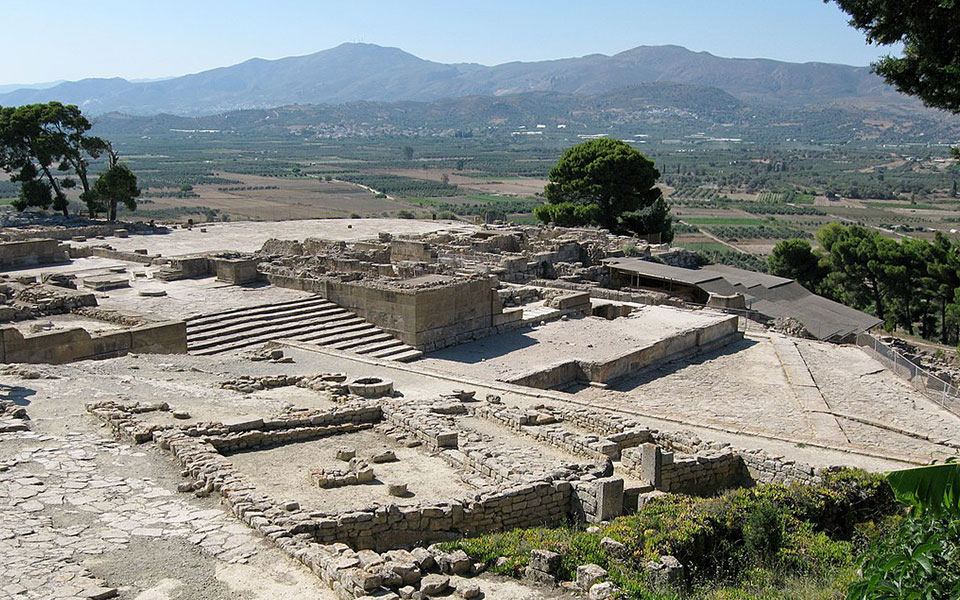
© Olaf Tausch / Public domain
Highlights
Monumental Entance: The Propylon, the monumental entrance to the palace is the most impressive known structure of its kind. A 14m wide staircase, which slopes downwards, served as a corridor to the Central Court.
Central Court: The nucleus of the palace is a 55m long central peristyle court around which the rooms are arranged, including the storerooms and shrines on the west side, the royal quarters on the north, and the workshops on the east.
West (Theatral) Court: To the west of the storerooms is the “theatrical area,” an open-air space believed to have been used for public performances and religious rituals.
Nearby Attractions
Agia Triada: A smaller Minoan villa complex nearby, offering additional insights into Minoan architecture and society.
Kommos Beach: A beautiful sandy beach a short drive from Phaistos, ideal for relaxing after exploring the ruins.

© Marc Ryckaert (MJJR) / Public domain
Gortyna, the Roman Capital of Creta et Cyrenaica
Remaining on the fertile Messara Plain, Gortyna, or Gortyn, is a site of immense historical and archaeological importance. Unlike the Minoan palaces of Knossos and Phaistos, Gortyna flourished during the Classical, Hellenistic, and Roman periods, serving as a prominent city in ancient Crete from approximately the 7th century BC to the 9th century AD. The site is renowned for its well-preserved ruins and the discovery of the “Gortyn Code,” one of Europe’s oldest and most comprehensive legal inscriptions.
Gortyna also served as the capital of the Roman province of Creta et Cyrenaica, which encompassed a region of North Africa (part of modern-day Libya). Archaeological excavations, started in the late 19th century by the Italian School of Archaeology at Athens, have revealed a wealth of structures and artifacts that illustrate the city’s long history and its role as a cultural, administrative, and religious center.
Gortyna is also significant for its early Christian history. The site is home to the Basilica of Saint Titus, named after the first bishop of Crete and a disciple of the Apostle Paul. The extant remains of this early Christian church, built in the mid-6th to early 7th century AD, indicate that it was a three-aisled basilica with a transept and dome. The interiors would have been richly painted.
Information
Location: 45km south of Heraklion.
Opening Hours: Open daily from 8:30am to 8:00pm in the summer months.
Ticket Price: Around €6 for adults, with concessions available for children and seniors.
Accessibility: The terrain is uneven, so comfortable footwear is recommended. Some areas may be challenging for those with mobility issues.

© Afrank99 / Public domain
Gortyn Code
One of the most remarkable discoveries at Gortyna is the Gortyn Code, an extensive legal inscription dating back to the first half of the 5th century BC. Carved into the stone walls of a public building in the agora (a “bouleuterion,” or assembly house), the Gortyn Code provides detailed insights into ancient Cretan law, covering aspects such as rape and adultery, divorce and marriage rights, property rights and inheritance, and the rights of slaves. This legal code is a crucial source for understanding the the early development of social and legal frameworks in ancient Greece.
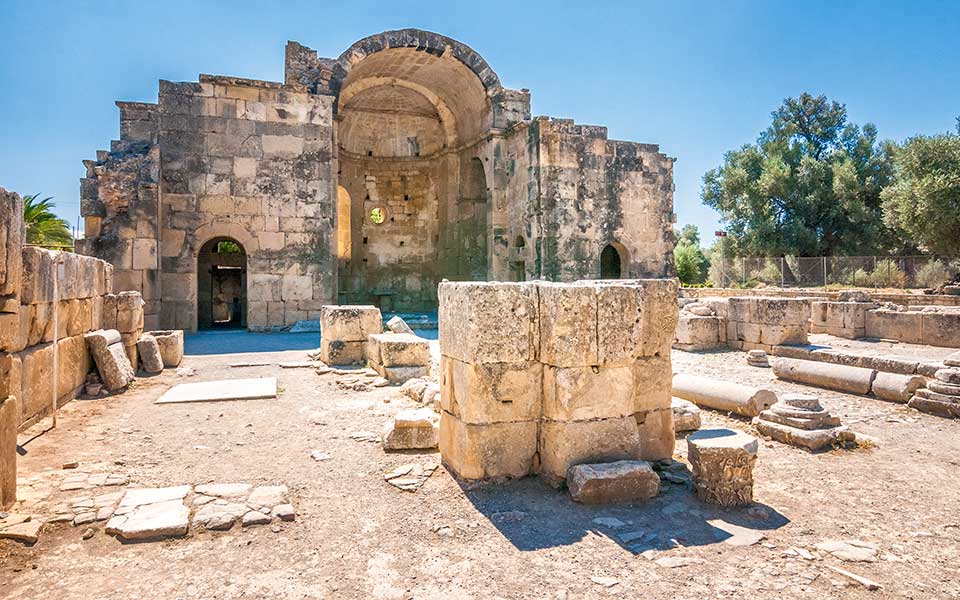
© Shutterstock
Highlights
The Praetorium: The Roman governor’s residence, built in the 1st century AD, showcasing the grandeur and administrative significance of Gortyna during the Roman period.
Temple of Apollo: One of the oldest temples on the site, dedicated to Pythian Apollo, reflecting the city’s religious practices. Nearby are the ruins of a temple dedicated to the worship of several Egyptian deities, Isis, Serapis, and Anubis.
Nymphaeum: An elaborate marble fountain, dating from the 2nd century AD. It was built to supply the Praetorium with a steady supply of fresh water – a precious commodity in arid Crete.
Roman Odeon: This small theatre, is another highlight of Gortyna. It was used for musical performances and public gatherings, reflecting the cultural activities of the city’s inhabitants. The Odeon’s well-preserved structure allows visitors to imagine the lively cultural life that once thrived in Gortyna.
Nearby Attractions:
Agioi Deka Village: A nearby village named after the Ten Martyrs of Gortyna, with a church and memorial dedicated to these early Christian saints.
Messara Plain: The surrounding plain offers opportunities for exploring traditional Cretan villages and enjoying the natural beauty of the region.
Malia Palace
Malia Palace, located on the north coast, 37km east of Heraklion, is the third-largest Minoan palace on the island. Known for its extensive ruins and unique artifacts, Malia offers a more intimate and less crowded experience compared to the more famous palaces of Knossos and Phaistos.
The palace served as an important administrative and religious center during the Minoan Bronze Age, from the early to mid-2nd millennium BC. The site was first excavated by French archaeologists in the early 20th century, revealing a wealth of information about ancient Cretan architecture, society, and economy.
Malia Palace is renowned for the discovery of the famous Minoan gold bee pendant, a masterpiece of ancient Cretan jewelry, now exhibited at the Heraklion Archaeological Museum. This exquisite piece, featuring two bees encircling a drop of honey, Discovered in a grave in the cemetery of the First or “Protopalatial” Period at Malia and dated to 1700 BC. Technically and stylistically influenced by the Egyptians and Babylonians, Minoan jewellers used smelting technology to refine gold and other precious metals to produce a staggering array of objects and designs. Finely crafted pieces like the bee pendant would have been beaten, engraved and embossed by hand.
Information
Location: 37km east of Heraklion.
Opening Hours: Typically open from 8:00am to 6:00pm in the summer months.
Ticket Price: Around €6 for adults, with discounts for children and seniors.
Accessibility: The site has uneven terrain, so comfortable footwear is recommended. Some areas may be challenging for those with mobility issues.
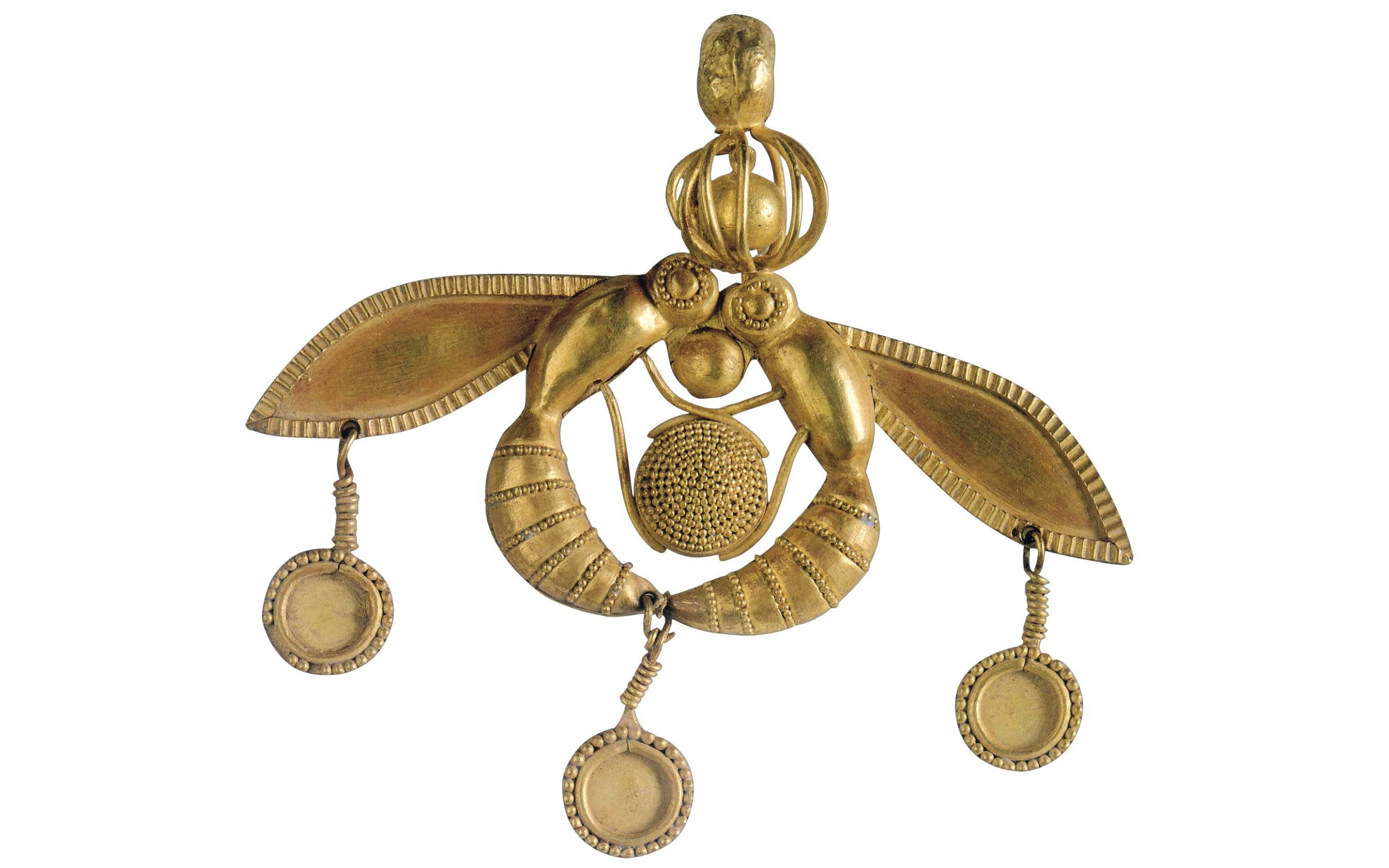
Highlights
Central Court: The heart of the palace, where religious ceremonies and public gatherings took place. The large central court is surrounded by storage rooms to the east, the theater and several crypts and corridors to the West
Area “M”: A large complex dating back to the Protopalatial period, located to the north-east of the palace, includes the remains of workshops, storage spaces, and cult rooms.
The Necropolis: Nearby excavations of the Necropolis at Chrysolakos (meaning “gold pit”) yielded a wealth of important Minoan artifacts, including the famous gold bee pendant.
Nearby Attractions
Malia Town: The nearby town of Malia offers a range of amenities, including restaurants, shops, and beaches, making it an excellent base for exploring the wider region.
Milatos Cave: A short drive from Malia, this cave has historical significance and offers a unique natural experience.
Zakros Palace
Zakros Palace, located on the east coast, is one of the island’s lesser-known but highly significant Minoan palaces, thanks to its protected harbor. The site’s remote location and well-preserved ruins make it a fascinating destination for archaeology enthusiasts and visitors seeking a quieter exploration away from the more crowded sites.
Zakros Palace played a crucial role in the history of Bronze Age Crete as a major commercial hub for trade to the east. This position facilitated extensive trade with Egypt, the Levant, and other parts of the Mediterranean. The site was first excavated in the early 20th century by archaeologist D.G. Hogarth of the British School at Athens, working under the auspices of the Cretan Exploration Fund. These excavations yielded Late Minoan houses and other valuable artifacts, including pottery, bronze tools, clay tablets, and a number of inscribed seals.
Renowned Greek archaeologist Nikolaos Platon took up the reins in the early 1960s, discovering the New Palace complex, a vast administrative center that covers an area of some 8000 square meters. It remains one of the best-preserved Minoan palaces.
Information
Location: 45km east of Sitia.
Opening Hours: Generally open from 8:30am to 6:30pm.
Ticket Price: Approximately €6 for adults, with reduced rates for children and seniors.
Accessibility: The site has uneven terrain, so comfortable footwear is recommended. Some areas may be challenging for those with mobility issues.

© Vladimír Držík / Public domain
Highlights
Central Court: With an area of 30 x 12 meters, the central court served as the focal point for public and religious activities, reflecting the palace’s importance as a social and ceremonial center.
Residential Quarters: The royal apartments and living spaces, complete with advanced drainage and water systems, can be found on the eastern wing of the Palace. The apartments for the king and the queen are separate.
Workshops and Storerooms: The west wing of the Palace features extensive workshops and storerooms, indicating the palace’s role in manufacturing and trade. These areas contained large pithoi (storage jars) for goods like oil, wine, and grain. One of the workshops is believed to be a place where faience pottery was made.
Sacred Areas: Religious spaces within the palace, including shrines and altars, highlight the spiritual practices and rituals of the Minoans. One of these rooms features a lustral basin, which may have been used in purification rituals.
Nearby Attractions
Gorge of the Dead: A nearby gorge with ancient Minoan tombs carved into the cliffs. It offers a scenic hike and an additional historical experience.
Kato Zakros Village: A charming village close to the palace, where visitors can enjoy local cuisine and hospitality.
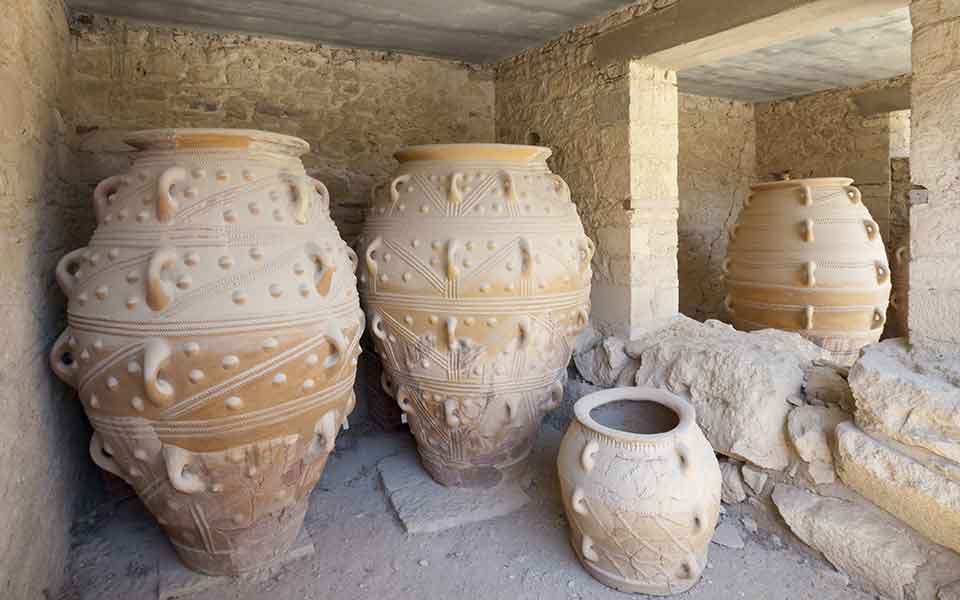
© Shutterstock
Tips for Visiting Archaeological Sites in Crete
Plan Ahead: Check the opening hours and ticket prices in advance, as they can vary seasonally.
Guided Tours: Consider taking a guided tour to enhance your understanding of the historical and cultural significance of each site.
Comfortable Footwear: Wear comfortable shoes, as you’ll be walking and exploring uneven terrain.
Stay Hydrated: Bring water, especially during the hot summer months.
Respect the Sites: Follow all guidelines and respect the archaeological sites to help preserve them for future generations.

